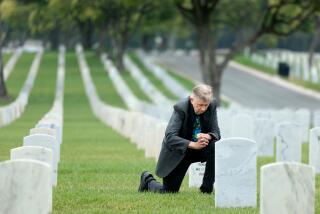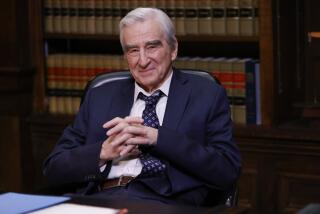A Lesson on Thinking Things Through
- Share via
Lawyers who don’t read one new how-to book before entering the courtroom of Los Angeles Superior Court Judge Charles W. McCoy Jr. could end up asking themselves why they didn’t think to.
That’s because McCoy is the author of a new primer on critical thinking, called “Why Didn’t I Think of That?”
His book is meant to teach the importance of thinking ahead and thinking things through--in other words, how to think perceptively and deliberately while systematically controlling the quality of thought.
If you think that sounds difficult, think again.
Mixing a little imagination with personal intuition and enough empathy to understand what others are feeling can help anyone learn to anticipate the unexpected, McCoy says.
Careful thought is usually required in his courtroom at the Central Civil West courthouse on Commonwealth Avenue in the McArthur Park area. McCoy is one of seven judges assigned to its two-year-old “complex litigation program”--where the Los Angeles court system’s thorniest and most convoluted civil cases end up.
Last year McCoy presided over the nation’s largest tobacco lawsuit trial, in which a jury ordered cigarette maker Philip Morris to pay a cancer victim $3 billion in damages. McCoy later reduced he award to $100 million, still a record. But plaintiff Richard Boeken of Topanga Canyon died earlier this year at age 57 before he saw any cash.
McCoy’s other cases have included lawsuits involving the Metropolitan Transportation Authority’s subway construction and last year’s state energy crisis.
The 55-year-old McCoy was appointed to the bench in 1992 by then-Gov. Pete Wilson. He had spent 18 years before that as a lawyer specializing in securities and antitrust litigation.
McCoy, a 6-foot-2-inch ex-Marine, says his book was prompted by his experiences as a rookie judge. “Sometimes I made my decisions too quickly and sometimes, I’m embarrassed to say, I allowed my own personal biases to shape my view of the particular case before I knew everything about the case,” McCoy acknowledged.
In those early days he would listen to arguments and think he had the right decision in mind. “But then very late in the case I’d discover some fact that, had I kept my mind open long enough, would have kept me from ever jumping in the wrong direction,” he said.
“That prompted me to think about my thinking ... thinking is like making a product. You need to think about thinking while you’re thinking in order to maintain the quality of that process.”
Office Filled With Important Reminders
McCoy’s chambers are filled with subtle reminders to avoid making snap decisions, to stay focused, to think systematically.
A strip of red masking tape stuck above the doorway leading into his courtroom calls out to him to “stop and think before you walk out there,” he said. “It says, ‘If you’re not ready to be fair, stop where you are.’”
A hunk of charred wood that McCoy plucked from a still-smoldering Koreatown storefront during the 1992 Los Angeles riots sits on his windowsill. “I keep it to remind myself the only thing that stands between us and chaos is the ability to be a just society,” he said.
A framed portrait of Winston Churchill hangs over his desk. Britain’s prime minister during World War II is McCoy’s personal hero--and a recurring subject in his book.
Churchill’s ability to think through the consequences of his options as he dealt with the threat of Adolf Hitler in 1940 is cited as an example of factoring the past, present and future into decision-making.
Vignettes involving such historical figures as Mt. Everest conqueror Sir Edmund Hillary, physicist Albert Einstein and automotive pioneer Henry Ford are also sprinkled throughout the book.
But it is the cases that echo the circumstances of those in McCoy’s own courtroom that bring the book to life. However, he acknowledges that he has shielded the true identity of litigants in those cases by fictionalizing them. “They are constructs,” he explained.
Likewise missing are references to celebrities who frequently pop up in front of McCoy. Litigants have included the bands Guns N’ Roses and the Red Hot Chili Peppers, actress Jenny McCarthy, boxer Mike Tyson and rapper Ice Cube.
“I wasn’t tempted to drop any celebrity names. I wanted to talk about things that ordinary people can experience,” he said.
“I think all of us, individually and collectively as a society, need to do a better job of thinking. Turn on the television and watch the talking heads. People are impressed with rhetoric. They tend to evaluate people on how good an argument they make rather than, ‘Well, is that a true argument? Is this the truth? Does this make sense?’
“As the world we live in gets more complicated and the communication system gets better and we’re more aware of what’s going on everywhere, we all must become better thinkers.”
Each chapter in the book, published by Prentice Hall Press, is illustrated with exercises that challenge readers to find hidden blind spots and loopholes in their logic. It’s a format that McCoy--who teaches law part time at Pepperdine University and Southwestern Law School--feels will appeal to a wide range of readers.
Although he wishes some lawyers who appear before him would read it and take its lessons to heart (“Sometimes nobody wants to get to the key issue--they want to fight for years on peripheral issues,” he shrugs). McCoy doesn’t talk about his book in court.
And most attorneys involved in his cases are apparently unaware what their judge has thought up.
“I don’t get that much free reading time, but I’d probably read that one,” said Kory Booth, a Woodland Hills lawyer frequently involved in “complex litigation” cases.
“As an attorney it always helps to know how your judge is thinking--or that he’s hopefully doing some thinking.”
More to Read
Sign up for our Book Club newsletter
Get the latest news, events and more from the Los Angeles Times Book Club, and help us get L.A. reading and talking.
You may occasionally receive promotional content from the Los Angeles Times.











